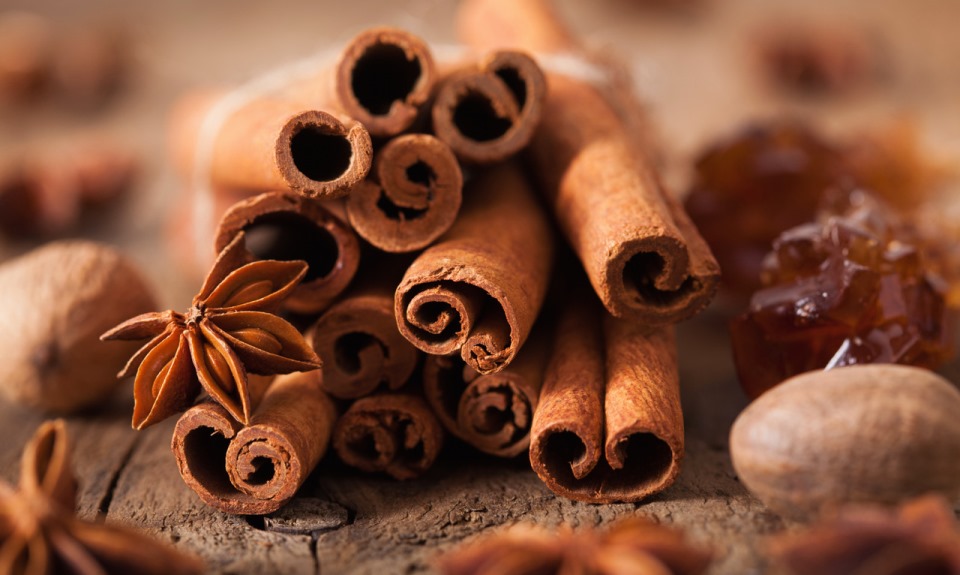During the Christmas season in particular, the smell of cinnamon is everywhere – for example, in Lebkuchen (a type of German gingerbread), biscuits and punch – without this spice Christmas wouldn’t be quite the same in Germany. Not all cinnamon is the same, however – there are some 250 different species of this genus, which belongs to the Lauraceae family [1]. In Europe the fine aromatic Ceylon cinnamon (Cinnamomum zeylanicum) from Sri Lanka is predominantly used and also the slightly more bitter Cassia cinnamon (Cinnamon cassia) from China [2].
Whether as a ground cinnamon powder or as a stick of cinnamon, this spice is always cultivated from the thin layer under the bark of the cinnamon tree which is “peeled” during harvesting, rolled together into several layers and dried. This is also a key feature of distinguishing the more expensive Ceylon cinnamon from Cassia cinnamon: the layers of so-called “real” cinnamon are rolled thinly, similar to a cigar. Cassia cinnamon, in contrast, is made from a thicker layer of bark.
Health and nutrition
In naturopathy cinnamon bark is traditionally used to treat inflammations and stomach diseases. Also in cases of nausea, colds and diarrhoea, the healing power of the plant have long been recognised and trusted. [1]. According to the Federal Institute for Drugs and Medical Devices (BfArM), cinnamon has a soothing effect in cases of loss of appetite, digestive problems, bloating and flatulence and can therefore claim the “character of a medicinal product” [3].
Pharmacological studies on the effect of the essential oils of cinnamon, primarily of cinnamaldehyde, show an anti-fungal and anti-viral effect as well as an impact on lowering cholesterol levels and lipids in the blood [1]. Cinnamaldehyde, however, can also cause skin irritations according to the BfArM [4].
The latest studies also suggest that the constituents of cinnamon could also increase the absorption of blood glucose [5]. This property would be especially interesting for people with type II diabetes, however the findings should still be considered with caution. The major concern in this context relates to the possible toxic effects of long-term consumption of an increased amount of cinnamon. For an adult a daily intake of over 2g Cassia cinnamon per day is not recommended, according to The Federal Institute for Risk Assessment (BfR). The cause for concern is the aromatic secondary plant substance coumarin which, at an increased dose, can lead, for example, to liver damage in persons susceptible to this. Cinnamon lovers should therefore opt for Ceylon cinnamon which is lower in coumarin. The suspicion that an increased intake of coumarin may lead to liver and kidney cancers, has not yet been proven by scientific investigations, however, [3] [6].
In the kitchen
Cinnamon can be used in the kitchen in just as many diverse ways as in medicine. We like to use the spice for sweet dishes such as rice pudding, fruit compote or cakes and soufflés. Even mulled wine and fruit juices gain a much fuller flavour through the addition of a little cinnamon. The pleasant-aromatic through to fiery-spicy character of cinnamon bark is also equally suitable for savoury dishes with Cayenne pepper and chilli, both of which bring out the spiciness of the cinnamon. Cinnamon does not blend quite so well with herbs such as basil or sage.
For a longer shelf life, it is recommended to buy cinnamon in the stick form as these can be kept for up to 4 years without any loss of flavour or smell. In its ground form, cinnamon should be stored in a cool, dry place with as much protection from light as possible. Ideally, it should be stored in a spice jar with an airtight lid as this will help it to keep its flavour for at least a few months [7].
Discover the diversity of cinnamon for yourself by trying one of our blog recipes:
Classically sweet:
- Cinnamon semolina dumplings with caramelised pear by Herbert Hintner
- Plum cake by Hans Haas
Or savoury:
- Haunch of wild rabbit in balsamic sauce by Thierry Thirvaudey
Sources:
[1] Y. Shen und e. al., „Beneficial Effects of Cinnamon on the Metabolic Syndrome, Inflammation, and Pain, and Mechanisms Underlying These Effects – A Review,“ J Tradit Complement Med., Bd. 2, Nr. 1, pp. 27-32, Jan-Mar 2012.
[2] AID-Infodienst, [Online].
[3] H. P. T. Ammon, „Zimt: Als Nahrungsergänzung nicht für Diabetiker geeignet,“ DtschArztebl, Nr. 105, pp. 51-52, 2008.
[4] „Besonderheitenliste des Bundesinstituts für Arzneimittel und Medizinprodukte (BfArM)/ / Version 1-10,“ März 2013. [Online]. Available: http://www.bfarm.de/SharedDocs/Downloads/DE/Arzneimittel/Zulassung/BSHL_Version1_10_14032013.pdf?__blob=publicationFile&v=1.
[5] P. A. Davis und W. Yokoyama, „Cinnamon Intake Lowers Fasting Blood Glucose: Meta-Analysis,“ Journal of medicinal food, Bd. 14, Nr. 9, pp. 884-9, april 2011.
[6] Bundesinstitut für Risikobewertung (BfR), „http://www.bfr.bund.de/cm/343/neue-erkenntnisse-zu-cumarin-in-zimt.pdf,“ 27 Sept. 2012. [Online].
